This blog, in the backdrop of World Radio Day, highlights the instrumental role Community Radio Alfaz-e-Mewat FM 107.8 played during the COVID-19 pandemic. In a country as vast and diverse as India, inclusion can only be achieved by strengthening communication that serves the people at the bottom of the pyramid, says Pooja Oberoi Murada and Arti Manchanda Grover.
CONTEXT
In a country as vast and diverse as India, inclusion can only be achieved by strengthening communication that serves the people on the lowest rungs of the pyramid. It is often said that two Indias exist within the same country, reflecting the large gap between the prosperous and the poor. Measures and actions need to be taken to bridge the ever-increasing gap to help the poor. Information sharing and awareness creation are the fundamental building blocks for achieving this, and community radio (CR) is one of the proven tools to accomplish this (Box 1).
| Box 1: Community Radio in India Discussions about CR in India began in the 1960s, beginning with the Chanda Committee Report 1966, which initiated the debate to end the monopoly of All India Radio (AIR). Then came the historic judgment of the Supreme Court in 1995, calling upon the government to draw up regulations for granting licenses to private broadcasters and establishing an autonomous and independent authority responsible for supervising all operational aspects of broadcasting. The Pastapur Initiative on Community Radio Broadcasting of 2000 urged the government to recognize community broadcasting as the third tier of broadcasting services, distinct from public and commercial broadcasting. Starting with the emergence of radio clubs to having a national broadcaster, from AM band to FM band, and opening it to different sectors, all these developments paved the way for the birth of community radio in India. CR stations serve as the sole source of information in many areas — especially in the media-dark areas and aspirational districts of the country. UNESCO sees community radio as a medium that gives voice to the voiceless, serves as the mouthpiece of the marginalized, and is at the heart of communication and democratic processes within societies. |
WORLD RADIO DAY
First proclaimed in 2011 by the member states of UNESCO, and adopted by the United Nations General Assembly in 2012 as an International Day, February 13 became World Radio Day (WRD).
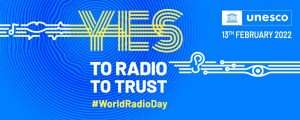
Radio celebrates humanity in all its diversity and constitutes a platform for democratic discourse. Globally also, radio remains the most widely consumed medium. Radio stations across the globe serve diverse communities, offer a wide variety of programs, viewpoints, and content, and reflect the diversity of audiences. Radio continues to be one of the most trusted and used media in the world, according to international reports. Radio has proven to be an effective medium that emerged as a savior during tough times. Trust in the medium grew further during the COVID-19 pandemic in early 2020 as radio served as an information lifeline in rural areas. The theme of the 2022 edition of World Radio Day is thus devoted to ‘Radio and Trust’.
When the entire world stood challenged, local community radio stations came to the rescue and continued their broadcasts to keep people informed and connected local authorities with the community. These community radios became the bridge between medical departments, administration, and the local people.
During such times of crisis community radios helped connect the local community to the government authorities and initiated information exchange. In this manner trust developed in the villagers to take informed choices to safeguard themselves. Radio broadcasters are trained on the principles of:
- Be first: as emergencies are time-sensitive, and information must be shared quickly;
- Be right: emphasizing accuracy of the shared information;
- ‘“Be credible: ensuring that a level of honesty and credibility is supreme at all times;
- Express empathy: which trains broadcasters to be courteous, kind, and responsive to all listeners and their calls;
- Promote action: which helps restore order, reach out to line departments with information and restore a sense of control; and
- Show respect: because respectful communication is particularly important when people feel vulnerable.
Abiding with these principles during times of disaster and emergencies help build rapport and trust of listeners in their community radio.
THE ROLE PLAYED BY CR DURING PANDEMIC
The case of Alfaz-e-Mewat
Community radio Alfaz-e-Mewat FM 107.8 – established by SM Sehgal Foundation, a rural development NGO – has five key programs: water management, agriculture development, local participation and sustainability, Transform Lives one school at a time, and Outreach for Development. It was at the forefront of the community right from the onset of the pandemic.
The station, located in district Nuh, Haryana, has been on air since 2012, bringing relevant information to the people. Nuh is one of most backward districts even though it is in close proximity to the national capital and the millennium city of Gurugram. The area is largely inhabited by an ethnic tribe, Meo Muslims, which is characterized by some of India’s lowest socioeconomic development indices.
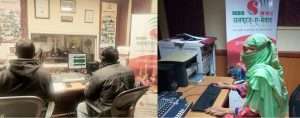 Broadcasting at Radio FM 107.8 Alfaz-e-Mewat
Broadcasting at Radio FM 107.8 Alfaz-e-Mewat
In order to address the pandemic, Alfaz-e-Mewat’s first broadcast started in February 2020 and was the sole source of information for the people during lockdown. The station is led by a group of community reporters and it broadcasts to cover local developments in the local language. Interviews featured doctors and people from the health department, who talked not only about the spread of the virus but also made regular announcements about government ration schemes. The station covered all relevant aspects of the pandemic. The trust and credibility portrayed in the medium stemmed from mapping the community’s needs and identifying the most vulnerable of the groups. The radio helped people access the various government entitlements extended during lockdown, such as monetary help in bank accounts, dry rations, etc.
Alfaz-e-Mewat produced short audio capsules on mental health and positive thinking through its program 21 din 21 baatein during the 21-day lockdown. The program, Aaj ka hero (today’s hero), addressed the reluctant population (some of them elderly) by profiling community members to narrate their personal accounts of how they are staying indoors and protecting themselves and their families. Through this the radio station highlighted that it was okay to be afraid of falling ill and so staying indoors during prayers. In keeping with the recommended use of minimal staff during the pandemic, the radio station ensured that only one person ran the show each day on a rotational basis, with equipment properly sanitized.
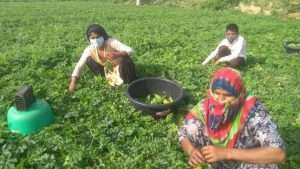 Farm women listening to radio during work
Farm women listening to radio during work
To counter false information on social media, the station started Savdhan (Alert!). These programs and initiatives during COVID helped make the fight against the pandemic everybody’s fight. In the midst of this challenging time, when people were averse to social distancing, getting tested on symptoms, and getting vaccinated, the station, using positive deviance inquiry, identified locals who set themselves up as examples by going against all the odds. These positive examples came from community members who came forward to be vaccinated themselves and shared their experiences with other listeners, thereby addressing any misconceptions about the safety of vaccines, including such concerns as that these were developed in haste, can change our DNA, or can be fatal, etc.
Radio broadcasts provided critical information to listeners in the coverage area of 225 villages. Rural schoolchildren tuned in to the radio for education amid the pandemic with Radio School. The Radio School program, created by community radio Alfaz-e-Mewat, was the only source of information for a number of children in the villages of this district. The program episodes covered the subjects of Maths, English, and Science for primary and secondary classes. Government school teachers also made recordings as part of a campaign facilitated by the State Education Department, along with educational content from Sesame Street, NCERT, and contributions made by volunteers and interns.
The station’s Radio School program served as a lifeline for rural kids. The station reporters even used the content for their kids, and several callers revealed that children were benefiting from the curriculum broadcasts of NCERT.
CONCLUSION
Community Radios represented a potent force that helped to deal with the difficulties arising from this pandemic; and they continue to act and evolve from providing relief to building resilience. The present focus of Alfaz-e-Mewat is to move to a ‘new normal’, preparing communities for the long battle ahead, and sustaining the safety of people.
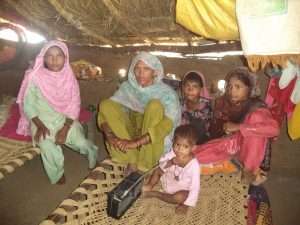
Women and children in rural Mewat listening to their own radio channel
Community radio’s role and importance has long been discounted but just as ‘When the going gets tough, the tough get going’, CRs have played an instrumental role during the pandemic, and remain positioned uniquely to reimagine communication that serves the people at the bottom of the pyramid. This became evident when community radio representatives were invited by the Health Ministry, Government of India, to get updates on the pandemic situation and to disseminate important messages regarding COVID-appropriate behavior and importance of vaccination to prevent spread of the disease. Alfaz-e-Mewat’s experiences are representative of the critical contributions community radios have made in the time of the pandemic.
To scale up radio’s reach, the government can invite applications and expedite the licensing and frequency allocation process so that each district in India has at least one community radio. Furthermore, CR can get the status of media so that it can be included in IEC planning of different campaigns that support the sustenance of Community Radios.
Bibliography
Sreedher R and Murada Pooja O. 2020. Community Radio in India. Aakar Books. Delhi.
Hoar Richard. How radio shaped the world. August 17, 2020.
https://www.gizmodo.com.au/2020/08/how-radio-shaped-the-world/
Manual John. 2014. Crisis and emergency risk communications. Environmental Health Perspective 122(8):A214–A219. https://www.ncbi.nlm.nih.gov/pmc/articles/PMC4122537
Murada Pooja O and Manchanda Grover Arti. 2021. Community Radio reaches the unreached during the pandemic: Stories from Alfaz-e Mewat. Chetana Quarterly 1:35–44. echetana.com/volume-6-1-january-march-2021/
 Pooja Oberoi Murada is Principal Lead, outreach for development at S M Sehgal Foundation & CR Alfaz-e-Mewat (Email: poojamurada@smsfoundations.org)
Pooja Oberoi Murada is Principal Lead, outreach for development at S M Sehgal Foundation & CR Alfaz-e-Mewat (Email: poojamurada@smsfoundations.org)
 Arti Manchanda Grover is Senior Program Lead, Outreach for Development, SM Sehgal Foundation, Haryana, India.
Arti Manchanda Grover is Senior Program Lead, Outreach for Development, SM Sehgal Foundation, Haryana, India.

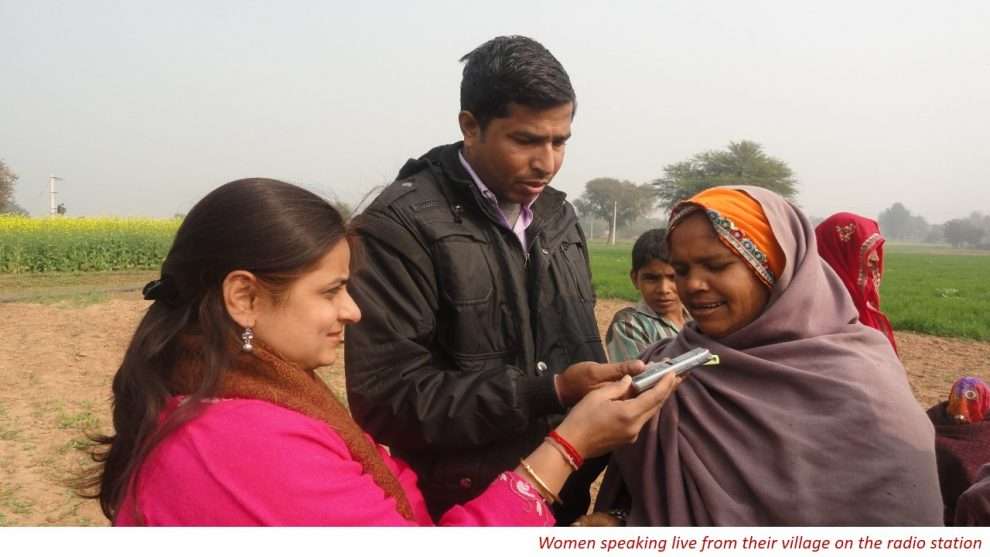

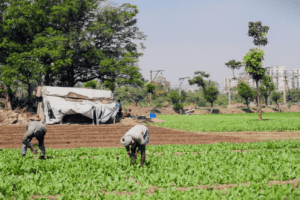

Well written Blog on Community Radio on the eve of World Radio Day. The Blog highlights how CR as a powerful communication medium/life line bridged the information gap to effectively manage life and livelihood hardships in remote villages during COVID-19 pandemic in 2020. The Program’s (Alfaz-e-Mewat) mission to move to new normal preparing communities for the long battle ahead and sustaining the safety of people in remote places is really laudable and deserves liberal support from all the concerned. Congrats to authors for a befitting Blog on the eve of World Radio Day!
The efforts of SM Sehgal Foundation in establishing and managing the CR Alfaz-e-Mewat FM 107.8.in the villages of Nuh district of Haryana during Covid 19 pandemic are laudable. The information needs of the people living in the backward district of Nuh of Haryana are being served very well by the CR. The CR has lot of potentiality in educating the people on several aspects and as suggested by the authors India needs more and more such CRs to cater to the requirements of the people. Congratulations to Pooja Oberoi and Arti Manchanda and thanks to AESA for bringing out this Blog on the occasion of World Radio day.